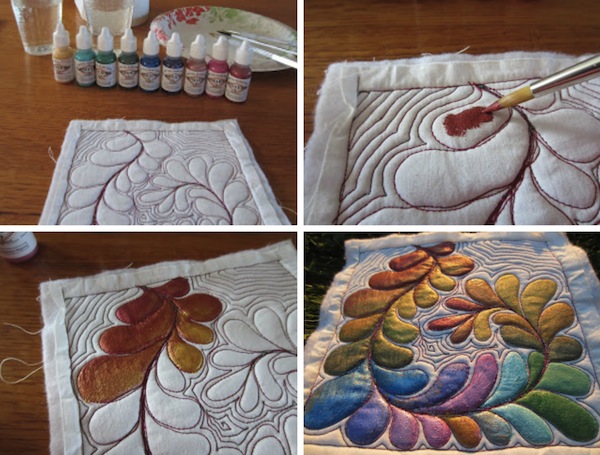Painting quilts is one way to achieve artistic and textural elements that really define your art. The subtle shading of fabric painting can provide depth and dimension that you just can’t achieve with patchwork alone. If you are drawn to portrait quilts or landscape quilts, you’ve probably seen this technique used quite often.
In order to understand fabric painting for quilters, it’s important to get a feel for the process, including the basic steps, materials needed and special techniques.

We’ve rounded up some great resources on fabric painting.
Acrylic paints
Before she gets started fabric painting, Sonji Hunt gathers trusted tools like a spray bottle, a drop cloth, and paintbrush. She mixes acrylic paints with water and rubs them into the cloth to blend in a background color. A spray bottle of water comes in handy to help with blending. The leaves are hand painted the next day, with touches of gold paint added in for the veins.

Colored pencils
Have you heard of using colored pencils to paint a quilt? The Tropical Fish mini quilt by Irena of Irena Bluhm Designs shows an example of this method. The fish design was first stitched onto the fabric on a computerized system. The coloring was then applied with colored pencils and fixed with a textile medium. Norma at Petit Design Co. shares a tutorial with instructions on how to combine colored pencils and fabric medium to achieve great painted quilts. You may choose to do the fabric painting either before or after quilting — it’s up to you!

Watercolor pencils
Watercolor pencils are another option for quilters interested in painting fabric. Carla Barrett of Feathered Fibers uses the pencils with a paintbrush and fabric medium mixed with aloe vera gel. You’ll want to choose a fabric that absorbs the liquid fabric medium well — try splashing a bit of water on the fabric sample before getting started to make sure it absorbs and doesn’t bead up. Draw directly on the fabric with watercolor pencils after saturating in the fabric medium.

Fabric paints
If acrylics or colored pencils aren’t your style, you can always pick up some paints that are designed specifically to be used on fabric. Pat at Color Me Quilty demonstrates how she uses metallic fabric paints on pre-quilted fabric to design a painted quilt block in rainbow colors. This is a great way to embellish a quilt and add depth and dimension.

Hand dyeing
There’s also the option to hand dye your fabrics first, before quilting. Linda Matthews created a fabric sample with a marbleized texture, which became the perfect palette for her free-motion quilted leaves. Glitter fabric paint and stamps with a smaller leaf design add another layer of design to the painted quilt. The combination of fabric dye, stamps and glitter paint makes this piece unique.
More Resources:
- Learn the process from expert Annette Kennedy in her Bluprint class Painting Pictorial Quilts.
- Quilting Daily shares a free e-book with step-by-step lessons for painting on fabric.
- Instead of using white fabric, start with a darker shade and do your fabric painting with bleach and a pencil eraser. See a tutorial from Paula Deen.
- Terri Stegmiller’s blog includes videos sharing how to paint fabric with colored pencils, Neocolor crayons, stencils and more.
For more inspiration, see our roundup of painted quilts. You may also enjoy the Bluprint class The Art of Cloth Dyeing with Jane Dunnewold and our post on fun techniques for dyeing fabric at home.

Share tips, start a discussion or ask one of our experts or other students a question.
No Responses to “Fun With Fabric Painting: Supplies and Techniques”